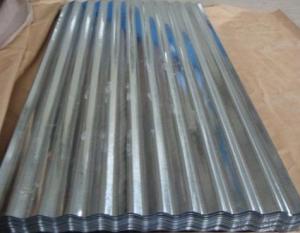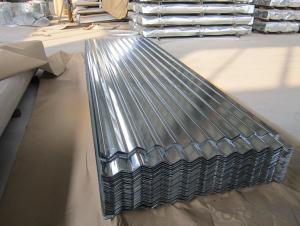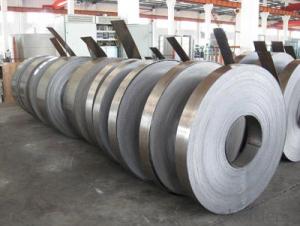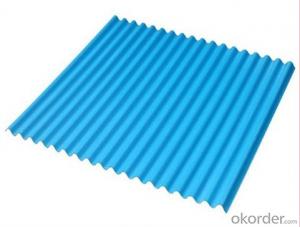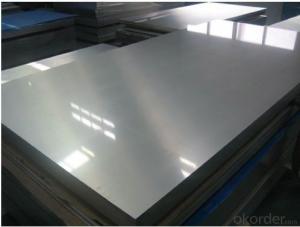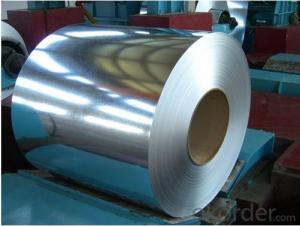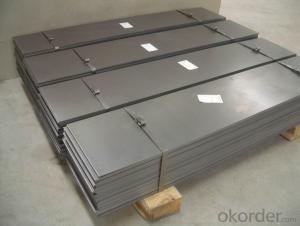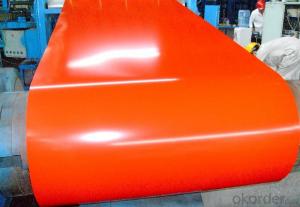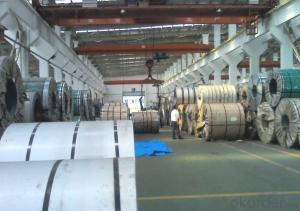Hot-Dipped Corrugated Steel Roofing Sheet
- Loading Port:
- Tianjin
- Payment Terms:
- TT OR LC
- Min Order Qty:
- 50 m.t.
- Supply Capability:
- 2000 m.t./month
OKorder Service Pledge
OKorder Financial Service
You Might Also Like
Item specifice
Product Brief Introduction
Hot-Dipped Corrugated Steel Roofing Sheet
--- Corrosion resistance: Pre-coated steel offers excellent corrosion resistance achived through continuous hot DIP galvanization and corrosion resistant primer/polyester coating. Protection is achieved when zinc and steel are together in the presence of moisture; The zinc protects the steel by galvanic action
Product Features
. Traditional aesthetics outlook
. Suitable for new house or renovation.
. Less joints, watertight
. Long life service
. Tedun also provide relative ridge cap, fasteners and other accessories
Product Specification
Standard:ASTM, GB,JIS,JIS G3302 ASTM 755 EN10169
Grade: DX51D CGCC CS
Thickness: 0.13mm~3.0mm,
Width: 1250,600-1250mm
Coil weight:3-12 MT
Coil ID:508/610mm
Chemical composition:
C | Si | Mn | Cr | Ni | P | S |
0.150 | 0.476 | 11.231 | 12.50 | 0.900 | 0.039 | 0.010
|
FAQ
How long will we receive the goods ?
45days after receiving workable L/C
how do you control the quality ?
we have our own quality control department ,we will arrange QC person to see the production line ,when goods finish ,before shipment ,our QC person will check the quality as per our test report request ,if the goods is ok ,then we issue the test report ,and we allow the goods shipping ,otherwise will not allow ship the goods.
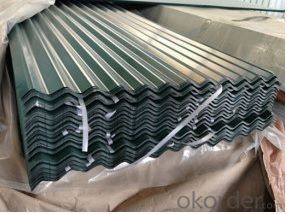
- Q:What are the different steel strip rolling processes?
- There are three main steel strip rolling processes: hot rolling, cold rolling, and warm rolling.
- Q:How are steel strips used in the energy sector?
- Steel strips are used in the energy sector for various applications such as manufacturing electrical transformers, power generation equipment, and transmission lines. They provide structural support, enhance conductivity, and help maintain the efficiency and reliability of energy infrastructure.
- Q:How do steel strips perform in springs and fasteners?
- Steel strips are commonly used in springs and fasteners due to their excellent strength and elasticity. The high tensile strength of steel allows the strips to withstand the forces and pressures exerted on springs and fasteners, ensuring durability and reliability. Additionally, steel strips have good flexibility, enabling them to bend and return to their original shape without deformation. This property is crucial in springs as it allows them to efficiently store and release energy. Overall, steel strips perform exceptionally well in springs and fasteners, providing the necessary strength, resilience, and longevity for these applications.
- Q:What is the maximum thickness of steel strips?
- The maximum thickness of steel strips can vary depending on a few factors such as the type of steel being used and the manufacturing process involved. Generally, steel strips can range in thickness from as thin as 0.001 inches (0.0254 mm) to as thick as 1 inch (25.4 mm) or even more in some specialized cases. However, it is important to note that the maximum thickness of steel strips is often determined by practical limitations such as the equipment and machinery available for processing and shaping the steel, as well as the intended application or industry standards. Therefore, it is advisable to consult specific steel manufacturers or industry guidelines to determine the maximum thickness for a particular steel strip application.
- Q:How are steel strips tested for decarburization?
- Steel strips are tested for decarburization using several methods to ensure the quality and integrity of the material. One common method is the use of visual inspection, where the surface of the steel strip is examined for any signs of decarburization such as discoloration or roughness. This visual inspection can be done manually or using automated systems. Another method is known as microhardness testing, which measures the hardness of the steel strip at different depths. Decarburization typically results in a decrease in hardness, so by comparing the hardness at different depths, it is possible to assess the extent of decarburization. Additionally, chemical analysis can be performed to determine the carbon content of the steel strip. Decarburization involves the loss of carbon from the surface layer, so by comparing the carbon content at different depths, the extent of decarburization can be determined. Metallographic examination is another technique used to test for decarburization. This involves preparing a cross-section of the steel strip and examining it under a microscope. The depth and severity of decarburization can be assessed by observing the presence of a decarburized layer and its thickness. Finally, non-destructive testing methods such as ultrasonic or eddy current testing can also be used to detect and assess decarburization in steel strips. These methods involve the use of sound waves or electromagnetic fields to detect any irregularities or changes in the material's composition. Overall, a combination of visual inspection, microhardness testing, chemical analysis, metallographic examination, and non-destructive testing is typically employed to comprehensively test steel strips for decarburization. This ensures that the material meets the required standards and is suitable for its intended application.
- Q:Are steel strips suitable for architectural applications?
- Yes, steel strips are suitable for architectural applications due to their high strength, durability, and versatility. They can be used in various architectural elements such as cladding, roofing, facades, and decorative features. Steel strips offer excellent resistance to corrosion and can be easily shaped and fabricated to meet specific architectural designs. Additionally, their aesthetic appeal and wide range of finishes make them a popular choice for modern architectural projects.
- Q:What is the difference between carbon steel and stainless steel strips?
- Carbon steel and stainless steel strips differ primarily in their composition and corrosion resistance. Carbon steel contains a higher amount of carbon, which enhances its strength and hardness. It is more affordable and commonly used for applications that require toughness, such as construction and machinery. Stainless steel, on the other hand, incorporates a higher level of chromium, which provides excellent corrosion resistance. Due to its ability to resist rust and staining, stainless steel strips are suitable for applications in food processing, medical equipment, and chemical industries.
- Q:How are steel strips processed for waterjet cutting?
- Steel strips are processed for waterjet cutting through a series of steps to ensure precision and accuracy. First, the steel strips are cleaned and prepared by removing any dirt, debris, or rust that may be present on the surface. This is done to ensure a clean and smooth cutting surface. Once the strips are cleaned, they are placed on a waterjet cutting machine. The machine is equipped with a high-pressure waterjet nozzle that shoots a stream of water mixed with an abrasive material, usually garnet, at extremely high speeds. This waterjet is capable of cutting through the steel strips with great precision. Before the actual cutting process begins, the waterjet cutting machine is programmed with specific cutting parameters. This includes the desired dimensions, shapes, and angles of the steel strips. The machine operator uses specialized software to input these parameters, which are then translated into instructions for the waterjet cutting machine. Once the cutting parameters are set, the machine operator starts the cutting process. The high-pressure waterjet is directed onto the steel strip, cutting through it with extreme accuracy. The waterjet can cut through various thicknesses of steel, ranging from thin strips to thicker plates, depending on the machine's capabilities. During the cutting process, the waterjet is constantly monitored to ensure the desired dimensions and shapes are being achieved. The machine operator may make adjustments to the cutting parameters if necessary to maintain accuracy. After the waterjet cutting is complete, the steel strips are carefully removed from the machine. They may undergo further processing, such as deburring or sanding, to ensure a smooth and finished edge. Overall, the process of waterjet cutting steel strips involves cleaning and preparing the strips, programming the cutting parameters, and using a high-pressure waterjet to precisely cut through the steel. This method is known for its accuracy, versatility, and ability to cut through various thicknesses of steel.
- Q:How are steel strips used in the manufacturing of automotive exhaust systems?
- Steel strips are commonly used in the manufacturing of automotive exhaust systems as they provide strength and durability. These strips are typically formed, welded, and shaped into the necessary components such as pipes, mufflers, and catalytic converters. The steel strips are resistant to high temperatures and corrosion, making them ideal for withstanding the harsh conditions of the exhaust system.
- Q:How are steel strips transported from the manufacturing facility to the end-user?
- Steel strips are transported from the manufacturing facility to the end-user through various modes of transportation. The most common methods include trucking, rail transportation, and shipping. Trucking is often employed for shorter distances or when the end-user is located in a nearby area. Steel strips are loaded onto flatbed trucks, which provide a convenient and efficient means of transportation. This method allows for flexibility in terms of timing and delivery locations, as trucks can access even remote areas. Rail transportation is preferred for longer distances or when the end-user is situated in a different region or country. Steel strips are loaded onto railcars, which are specifically designed to carry heavy loads. Rail transport offers cost-effective solutions due to its ability to carry large quantities of steel strips at once. Additionally, it is a more environmentally friendly option compared to trucking. Shipping is utilized when the end-user is located in a different country or continent. Steel strips are loaded into containers and transported via cargo ships. This method is suitable for long-distance transportation and allows for efficient movement of large volumes of steel strips at a time. However, shipping may take longer compared to other modes of transportation due to the time required for customs clearance and port handling. Regardless of the mode of transportation chosen, it is crucial to ensure the proper packaging and securing of steel strips to prevent damage during transit. Additionally, logistics companies and freight forwarders play a vital role in coordinating the transportation process, including arranging the necessary documentation, customs clearance, and tracking the shipment to ensure timely delivery to the end-user.
1. Manufacturer Overview |
|
|---|---|
| Location | |
| Year Established | |
| Annual Output Value | |
| Main Markets | |
| Company Certifications | |
2. Manufacturer Certificates |
|
|---|---|
| a) Certification Name | |
| Range | |
| Reference | |
| Validity Period | |
3. Manufacturer Capability |
|
|---|---|
| a)Trade Capacity | |
| Nearest Port | |
| Export Percentage | |
| No.of Employees in Trade Department | |
| Language Spoken: | |
| b)Factory Information | |
| Factory Size: | |
| No. of Production Lines | |
| Contract Manufacturing | |
| Product Price Range | |
Send your message to us
Hot-Dipped Corrugated Steel Roofing Sheet
- Loading Port:
- Tianjin
- Payment Terms:
- TT OR LC
- Min Order Qty:
- 50 m.t.
- Supply Capability:
- 2000 m.t./month
OKorder Service Pledge
OKorder Financial Service
Similar products
New products
Hot products
Hot Searches
Related keywords
